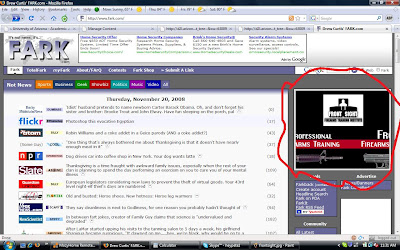A threaded barrel designed to accommodate a flash suppressor
or silencer. A silencer is useful to assassins but clearly has no
purpose for sportsmen. Silencers are also illegal.
(Emphasis in the original.)
From Mass Produced Mayhem, a pamphlet published by the Brady Campaign saying why “assault weapons” are evil and should be banned. This particular part is located on Page 21, as part of a list of “combat features” that certain guns have that “have no sporting value”.
While the entire document is pretty much bunk, this particular bit stands out to me due to my ownership of several firearms with threaded barrels and a silencer.
Silencers are not illegal. In case the bold print wasn’t enough, let me repeat: silencers are NOT ILLEGAL. They are regulated under the National Firearms Act of 1934 and by state laws. In a few states, ownership or use of silencers may be banned outright, or so heavily restricted that they are effectively banned. However, most states either have very light regulations or defer to federal laws.
The process to legally acquire one is the same for acquiring any other NFA-regulated item: payment of a $200 tax, addition to the NFA registry, local police approval, federal (ATF) approval, a detailed background check, a full set of fingerprints, etc. All in all, it takes about a month to get all the paperwork sorted out.
That said, what does the Brady Campaign hope to stop if they banned guns with threaded barrels? Hypothetically, if silencers were illegal, what would a ban on threads accomplish? It would already be illegal to own silencers…would making their mounting point “more illegal” somehow reduce the already extremely-rare (to the point of being unheard of outside of movies) criminal use of silencers?
Silencers have plenty of perfectly legitimate purposes, both for sportsmen and ordinary shooters. For example, a hunter could use a silencer so as not to alarm other game animals within earshot (thus being polite to other hunters by not scaring away their game). A hunter might also find a silencer useful if hunting in lands that are within earshot of communities, so as not to annoy neighbors. Not needing to carry bulky earmuffs (which reduce one’s perception of the surrounding areas, and thus limit the ability to detect game animals) is beneficial, as well as reducing the risk of hearing damage. Indeed, in many areas in Europe, the use of suppressors is encouraged for sportsmen and hunters for these very reasons.
Ordinary shooters find silencers to be quite handy as well: I find them excellent for teaching new shooters, as there is no loud noise emitted when the gun is fired. This allows new shooters to get introduced to the sport without developing flinching and other negative behaviors. Arizona gets quite hot, and earmuffs can make one’s ears quite uncomfortable (hot, sweaty, etc.), so a silencer is beneficial by making earmuffs unnecessary while keeping noise at safe levels. Many guns are extremely loud, and by using a silencer, I can reduce the noise emitted by my guns, so as not to annoy fellow shooters at the range, those living near the range (granted, the range where I shoot is extremely remote, and nobody lives around it for miles in all directions), and so on. It’s simply a matter of being neighborly.
Silencer-using assassins are all but unheard of outside of hollywood movies. Those few assassins that do exist are likely to be trained and operated by governments…governments who don’t really give a damn about (or are exempt from) US firearms laws. While high quality silencers require the use of a machine shop, the knowledge and equipment needed is minimal and an amatuer could construct a workable, durable silencer in the time of a few hours. Threading a firearm barrel is even easier. Flimsy, novelty, less effective (but by no means less regulated) silencers can be made with homemade equipment and no machine shop in an hour or two.
That said, this proposal isn’t about the legality or illegality of silencers, it’s simply about their mounting points. I’m curious if such a law, if implemented, would ban the use of quick-disconnect lugs or other non-threaded mounting devices for various muzzle accessories?
